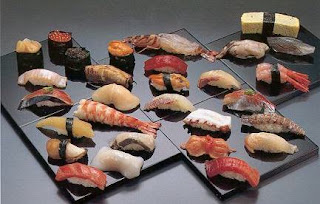Most readers have recently noticed the proliferation of Sushi restaurants, take-a-ways, or availability in some Supermarkets.
Sushi has gained notoriety, when in a recent past it was seen by most simply by a Japanese raw fish dish. Of course that Sushi is more than that.
I confess that I have only tasted Sushi almost by accident when visiting the dorm of University College of London, one of the students was eating some Hosomaki (thin rolls), and curious me, simply asked the girl if it was good. She then offered me a small piece and from then on it was a roller coaster of experiences, learning, reading cook books and talking with some Sushi Chefs.
Sushi as you all know, is a Japanese dish, probably the most known Japanese gourmet life style. Of course that not all Japanese cuisine is Sushi, nothing more wrong, they have a rich variety of food, Sushi is just one of many forms of Japanese cuisine.
If you belong to the class of people that are now escaping from Sushi because it became popular you are escaping from an healthy life style. Sushi can be easily prepared at home. I do it myself, and my family enjoys it quite much.
The first rule of Sushi is quality. When choosing a Sushi restaurant, be sure that the Chef is Japanese;
unfortunately there are many Chinese Sushi Restaurants. The quality is bad and such place is ruining
the Sushi experience to many. If the Chef is Brazilian, it is not bad, as you might not know, Sao Paolo is the
largest Diaspora of Japanese emigrants in the world, so with time, they have taught the art of Sushi to some
good Brazilian Chefs.
The Sushi can be accompanied with Sake (Rice Fire Water), or with a good dry Japanese Beer (Asahi is
fine).
In your first experience don’t exaggerate in the doses. You should start with a simple Hosomaki mix, in
order to get acquainted with the flavours and texture of the Sushi. Piece of advice, the Ginger and the
Wasabi (kind of Mustard) are not choices that one can have or have not. You must put a bit of Wasabi
over the role, then a piece of ginger before you dip it in the Soya sauce. You should eat the slice in one go,it
is considered rude to eat Sushi in half’s or cut in small pieces. Sushi usually comes in small portions that can
be easily eaten in one go.
Going back to Wasabi and Ginger, they are consider natural antiseptics and you should eat it in order to
protect your stomach from eventual harmful enzymes present in raw fish.
Sushi is a wonderful experience; it is healthy and highly digestible food.
You shouldn’t eat Sushi more than twice a week.
If you have enjoyed your meal, it is considered polite to offer the Sushi Chef a beer.
If you want to start preparing it at home, there are many nice Japanese cook books, but the best advice is to
sit next to the Chef in your favourite Sushi restaurant, you will learn its tricks simply by looking carefully.
Last but not least piece of advice, do not eat with fork and knive.
Bon Apetit.
Chef Gourmet Du Art
Curiosities: 1) In Japan, women are not allowed to prepare Sushi, as they have warmer hands and it might affect the quality of the raw ingredients; 2) The Sushi was introduced in Japan by the Chinese; 3) Sushi means “it’s sour”.
Places where I have enjoyed good Sushi: Restaurant “Terra” Oporto, Portugal, Restaurant “Arcadia” Torino, Italia, Restaurant “Akira” Köln, Germany, Restaurant “Kinoshita” Sao Paolo, Brazil, Restaurant “Origami” Lisbon, Portugal







